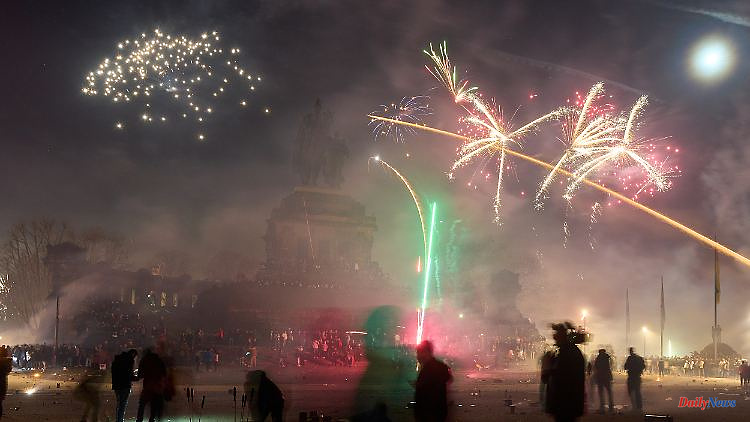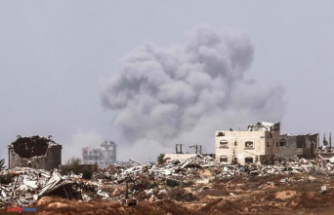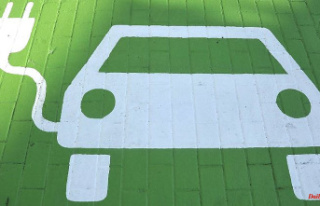With the ignition of firecrackers and rockets, a lot of fine dust gets into the atmosphere. An evaluation of air quality data shows when and where there was bad air on New Year's Day - and why on the night of January 1, 2023, New Year's Eve was comparatively "clean", at least in parts of Germany.
The traditional fireworks display on New Year's Eve is fun and exciting for many people, but it comes with all sorts of problems. In addition to fires and injuries, the collective ignition of rockets and firecrackers also pollutes the environment. According to the Federal Environment Agency (UBA), around 2050 tons of fine dust are released every year by pyrotechnics, three quarters of which are attributable to New Year's Eve. This corresponds to around one percent of the fine dust emitted annually in Germany. The first day of the year is usually also the day with the highest air pollution.
The level of pollutants in the air is measured in micrograms per cubic meter (µg/m³). According to UBA, the German annual average in 2021 was 14 µg/m³ in urban areas and 11 µg/m³ in rural areas. The UBA estimates an hourly average of up to 40 µg/m³ as harmless. The first negative effects can occur at a load of 41 to 100 µg/m³. Any value above this is considered harmful to health, and outdoor physical activity is discouraged.
Note on the graph: You can use the drop-down menu at the top left to call up the values for the years 2020 to 2022 and compare them with 2023.
This critical mark is regularly broken on New Year's Eve. Example Munich: On January 1, 2023, the inner-city measuring station Stachus determined a fine dust value of 76 µg/m³. On New Year's Day 2020 it was even 175 µg/m³. In the intervening years, when the sale of firecrackers to private individuals was prohibited as part of the Corona measures, the measured value was significantly lower. Nationwide, the fine dust pollution from fireworks fell by 90 percent in some cases during this time.
A high level of particulate matter pollution can pose a health risk, especially for risk groups such as children, the elderly, asthmatics and people with lung diseases. Typical symptoms are coughing and difficulty breathing. But even in healthy people, fireworks often cause a sore throat or a burning sensation in the eyes. If fine dust emissions are permanently increased, the microscopic fine particles can settle in the lungs and bronchi, get into the blood and cause cardiovascular diseases.
Experts have been warning of the health consequences of the annual banging for years. "How big the actual fine dust pollution is on New Year's Eve and how quickly it subsides again depends on the weather conditions," says UBA meteorologist Ute Dauert. The particulate matter levels often drop back to normal levels within a few hours. Depending on the weather, the particles can remain in the air for days.
The most important thing is the wind. "The weaker the wind, the greater the accumulation of particulate matter," says ntv.de meteorologist Björn Alexander. “A lot of wind and rain, on the other hand, ensure that the fine dust is quickly blown away or washed out.
The "Böller Nebel" in 2020 showed the immense effects that the interaction of weather and fireworks can sometimes have. At that time, there was almost no wind in some parts of the country on New Year's Eve. In addition, various weather factors prevented so-called "firework dirt" or "fog of horror", as the German weather service called it at the time, from escaping upwards. Shortly after midnight, the fine dust pollution increased massively and a dense wall of fog formed. In western and southern Germany in particular, visibility was sometimes less than ten meters, resulting in traffic chaos with many accidents. The ambulance and fire brigade could no longer get through.
This is also reflected in the data. On January 1, 2020, the limit of 50 µg/m³ was exceeded at 205 measuring stations. For comparison: In the two Corona years 2021 and 2022 there were only one each. On New Year's Day 2023, the number rose again to 39 stations. "For the past New Year's Eve, it can be said overall that we experienced a windy turn of the year," says meteorologist Alexander. Only in the south was there rather weak wind. "In relative terms, a higher load should have occurred here." This assessment corresponds to the air values, according to which critical particulate matter values were reached in Bavaria and parts of Baden-Württemberg in particular.
But what follows from this? Basically, chronic air pollution weighs more heavily than the short-term outlier on January 1st. But it is also clear that any fine dust pollution is potentially harmful to health and the environment - and especially in the case of New Year's Eve banging, the additional air pollution would be easily avoidable. In addition, pyrotechnics release particularly toxic substances that irritate the respiratory tract. The Federal Environment Agency is therefore calling for the New Year's firecrackers to be restricted or, at best, to be dispensed with altogether.
(This article was first published on Tuesday, January 03, 2023.)












